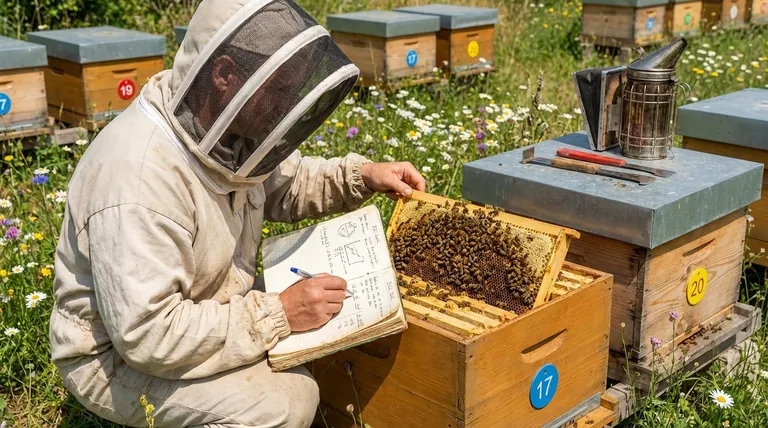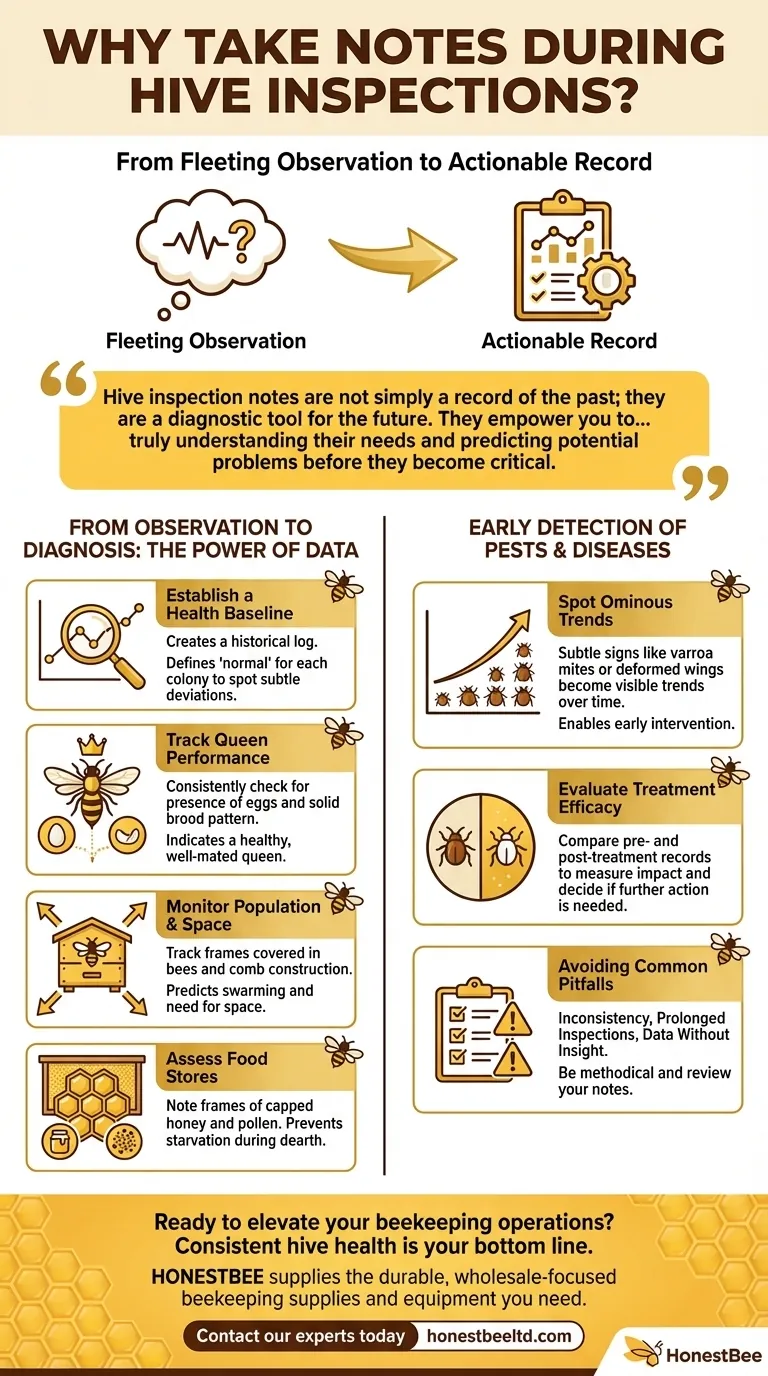Taking notes during a hive inspection is essential because it transforms a fleeting observation into a permanent, actionable record. This data allows you to track changes over time, diagnose the colony's health, and make informed management decisions instead of relying on fallible memory.
Hive inspection notes are not simply a record of the past; they are a diagnostic tool for the future. They empower you to move from simply looking at your bees to truly understanding their needs and predicting potential problems before they become critical.

From Observation to Diagnosis: The Power of Data
Your notes create a historical log that provides context for every future inspection. Without this data, you are essentially starting from scratch every time you open the hive.
Establishing a Health Baseline
The first few inspection records for a hive establish what is "normal" for that specific colony. Every hive has its own unique personality and patterns.
This baseline is your most critical reference point. Without it, you cannot accurately identify subtle deviations that may signal an emerging problem.
Tracking Queen Performance
A healthy queen is the heart of a productive colony. Your notes are the primary tool for monitoring her.
Consistently checking for the presence of eggs is more important than always finding the queen herself. A solid, continuous brood pattern (eggs, larvae, and capped brood in concentric circles) indicates a healthy, well-mated queen. Notes that show a spotty or inconsistent pattern over several weeks are a clear sign that the queen may be failing.
Monitoring Population and Space
Your notes help you track the colony's natural cycle of expansion and contraction.
Recording the number of frames covered in bees and the progress of comb construction tells you if the population is growing as expected. This data is how you accurately predict the need for more space, preventing a swarm by adding another box at the right time.
Assessing Food Stores
A colony's survival depends on its food reserves. Guesswork is not a reliable strategy.
By noting the number of frames containing capped honey and stored pollen, you can determine if the bees have enough resources. This helps you decide when to feed the colony during a nectar dearth or when it's appropriate to harvest a surplus.
Early Detection of Pests and Diseases
Problems in a beehive rarely appear overnight. They begin with subtle signs that are easy to miss or forget without a written record.
Spotting Ominous Trends
A single deformed wing or a few varroa mites might not seem alarming. However, notes allow you to see if that number is increasing with each inspection.
Recording observations like "3-4 chalkbrood mummies" or "saw 5 varroa mites on bees" creates a timeline. This transforms a minor observation into a trend, allowing you to intervene before a small issue becomes a full-blown infestation or infection.
Evaluating Treatment Efficacy
If you treat a hive for pests or disease, your notes are the only objective way to know if the intervention was successful.
By comparing your records of pest levels or disease symptoms from before and after the treatment, you can measure its impact and decide if further action is needed.
Common Pitfalls to Avoid
While crucial, the practice of note-taking has potential downsides if not done thoughtfully.
Inconsistency
Sporadic or incomplete notes can be misleading. A record is only useful if it is maintained consistently, allowing for reliable comparisons from one inspection to the next.
Prolonged Inspections
The act of taking detailed notes can extend the time the hive is open, which chills the brood and stresses the colony. Develop an efficient shorthand or use a pre-made template to be quick and methodical.
Data Without Insight
The goal is not simply to collect data, but to review it later to gain understanding. Set aside time after your inspections to read through your notes and think about what they are telling you about the hive's trajectory.
How to Apply This to Your Beekeeping
Your record-keeping system should match your goals and scale. The key is to choose a method and stick with it.
- If you are a new beekeeper: Start with a simple checklist to ensure you consistently look for the queen, eggs, brood pattern, pest signs, and food stores.
- If you manage multiple hives: Use a standardized template for each hive to easily compare the performance and health of different colonies.
- If your focus is on improving hive health: Dedicate specific sections in your notes to pest counts and disease symptoms to track the effectiveness of your management strategies.
A consistent record-keeping habit is the most powerful tool for becoming a proactive and successful beekeeper.
Summary Table:
| Key Aspect to Track | What to Note | Why It Matters |
|---|---|---|
| Queen Performance | Presence of eggs, brood pattern consistency | Identifies a failing queen early |
| Population & Space | Frames covered in bees, comb construction | Predicts swarming, prevents overcrowding |
| Food Stores | Frames of capped honey & pollen | Ensures colony survival during dearth |
| Pests & Diseases | Counts of mites, signs of disease (e.g., chalkbrood) | Enables early intervention before crisis |
Ready to elevate your beekeeping operations?
As a commercial apiary or equipment distributor, consistent hive health is your bottom line. HONESTBEE supplies the durable, wholesale-focused beekeeping supplies and equipment you need to manage your hives efficiently, from inspection tools to mite treatments.
Contact our experts today to discuss how our products can support your data-driven beekeeping practices and improve your colony's productivity and health.
Visual Guide

Related Products
- Professional Engraved Round Hive Number Tags for Beekeeping
- Professional Galvanized Hive Strap with Secure Locking Buckle for Beekeeping
- Versatile Ratchet Hive Strap with S-Hooks for Secure Fastening
- Professional Long-Handled Silicone Honey Scraper for Beekeeping
- Heavy-Duty Galvanized Steel W-Style Pallet Clip
People Also Ask
- How can hive stands be made more secure in windy areas? Anchor Your Apiary Against the Elements
- How should a Posca pen be prepared for queen marking? Ensure a Safe, Precise Mark Every Time
- What is the best height for a hive stand? Optimize for Pest Control and Beekeeper Ergonomics
- What maintenance is required for hive straps? A Guide to Cam Buckle vs. Ratchet Strap Care
- Why is it recommended to buy at least two bee hives? Boost Your Success with a Second Colony



















